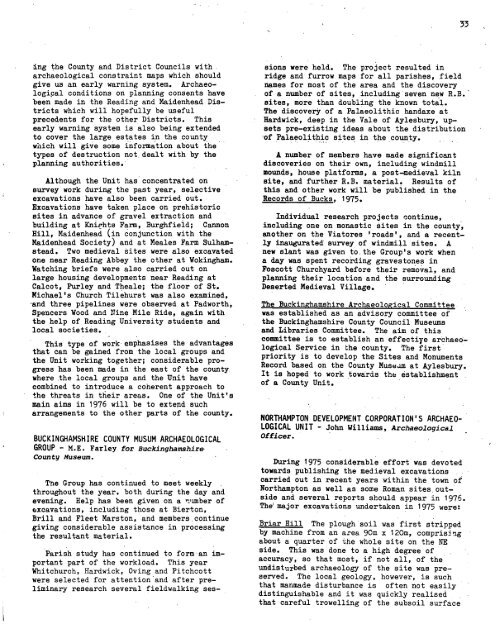Untitled - Council for British Archaeology
Untitled - Council for British Archaeology
Untitled - Council for British Archaeology
Create successful ePaper yourself
Turn your PDF publications into a flip-book with our unique Google optimized e-Paper software.
.<br />
33 ,<br />
ing the County and District <strong>Council</strong>s with<br />
archaeological constraint maps which should<br />
give us an early warning system. Archaeological<br />
conditions on planning consents have<br />
been made in the Reading and Maidenhead Districts<br />
which will hopefully be useful<br />
precedents <strong>for</strong> the other Districts. This<br />
early warning system is also being extended<br />
to cover the large estates in the county<br />
which will give some in<strong>for</strong>mation about the<br />
types of destruction not dealt with by the<br />
planning authorities.<br />
Although the Unit has concentrated on<br />
survey work during the past year, selective<br />
excavations have also been carried out.<br />
Excavations have taken place on prehistoric<br />
sites in advance of gravel extraction and<br />
building at Knirhts Farm, Burghfieid; Cannon<br />
Hill, Maidenhead (in Conjunction with the<br />
Maidenhead Society) and at Meales Farm Sulhamstead.<br />
Two medieval sites were also excavated<br />
one near Reading Abbey the other at Wokingham.<br />
Watching briefs were also carried out on<br />
large housing developments near Reading at<br />
Cabot, Purley and Theale; the floor of St.<br />
Michael's Church Tilehurst was also examined,<br />
'and three pipelines were observed at Padworth,<br />
Spencers Wood and Nine Mile Ride, again with<br />
the help of Reading University students and<br />
local societies.<br />
This type of work.emphasises the advantages<br />
that can be gained from the local groups and<br />
the Unit working together; considerable progress<br />
has been made in the east of the county<br />
where the local groups and the Unit have<br />
combined to introduce a coherent approach to<br />
the threats in their areas. One of the Unit's<br />
main aims in 1976 will be to extend such<br />
arrangements to the other parts of the county.<br />
BUCKINGHAMSH IRE COUNTY MUSUM ARCHAEOLOGICAL<br />
GROUP - M.E. Farley <strong>for</strong> Buckinghamshire<br />
County Museum.<br />
The Group has continued to meet weekly .<br />
throughout the year. both during the day and<br />
evening. Help has been given on a number of<br />
excavations, including those at Bierton,<br />
Brill and Fleet Marston, and members,continue<br />
giving considerable assistance in processing<br />
the resultant material.<br />
Parish study has continued to <strong>for</strong>m an important<br />
part of the workload. This year<br />
Whitchurch, Hardwick, Oving and Pitchcott<br />
were selected <strong>for</strong> attention and after preliminary<br />
research several fieldwalking ses-<br />
sions were held. The project resulted in<br />
ridge and furrow maps <strong>for</strong> all parishes, field<br />
names <strong>for</strong> most of the area and the discovery<br />
of a number of sites, including'seven new R.B.<br />
sites, more than doubling the known total.<br />
The discoverY of a Palaeolithic handaxe at<br />
Hardwick, deep in the Vale of Aylesbury, upsets<br />
pre-existing ideas about the distribution<br />
'of Palaeolithic sites in the county.<br />
A number of members have made significant<br />
discoveries on their own, including windmill<br />
mounds, house plat<strong>for</strong>ms, a post-medieval kiln<br />
site, and further R.B. material. Results of<br />
this and other work will be published in the<br />
Records of Bucks, 1975.<br />
Individual research projects continue,<br />
including one on monastic Sites in the county;<br />
another on the Viatores 'roads', and a recently<br />
inaugurated' survey of windmill sites. A<br />
new slant was given to, the Group's work when<br />
a day was spent recording gravestones in<br />
Foscott Churchyard be<strong>for</strong>e their remoVal, and<br />
planning their location and the surrounding<br />
Deserted Medieval Village.<br />
The Buckinghamshire Archaeological Committee<br />
was established as an advisory committee of<br />
the Buckinghamshire County <strong>Council</strong> Museums<br />
and Libraries Committee. The aim of this<br />
committee is to establish an effectiye arChae6-<br />
logical Service in the county. The first.<br />
priority is to develop the Sites and Monuments<br />
Record based on the County Museum at Aylesbury.<br />
It is hoped to work towards the establishment .<br />
of a County Unit.<br />
NORTHAMPTON DEVELOPMENT CORPORATION'S ARCHAEO-<br />
LOGICAL UNIT - John Williams, Archaeological<br />
Officer.<br />
During 1975 considerable ef<strong>for</strong>t was devoted<br />
towards publishing the medieval excavations .<br />
carried out in recent years within the town of<br />
Northampton as well as some Roman sites.outside<br />
and several reports should appear in 1976.<br />
The major excavations undertaken in 1975 were:<br />
Briar Hill The plough soil was first stripped<br />
by machine from an area 90m x 120m, comprising<br />
about a quarter of the whole site on the NE<br />
side. This was'done to a high degree of<br />
accuracy, so that most, if not all, of the<br />
undisturbed archaeology of the site was preserved.<br />
The local geology, however, is such<br />
that manmade disturbance is often not easily<br />
distinguishable and it was quickly realised<br />
that careful trowelling of the subsoil'surface

















